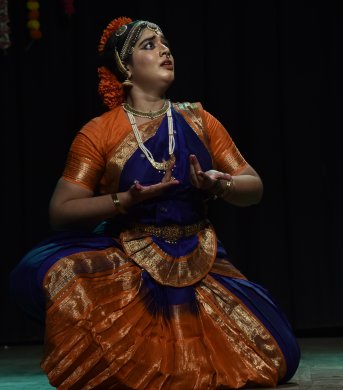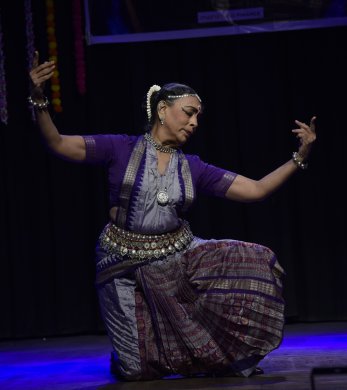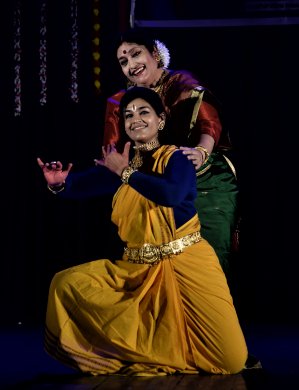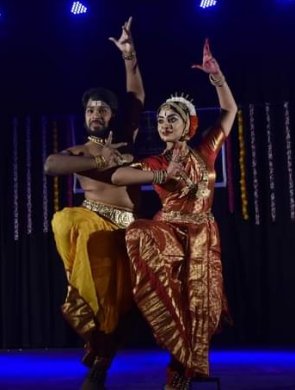
|   |

|   |
Celebrating dance through Ardhang and Diksha - Vijay Shanker e-mail: vijaydance@gmail.com May 18, 2023 It was a celebration of 'Art to heart with Diksha - then and now' enlightened by eminent practitioners of the art at the conference room of Mysore Association, Mumbai. The speakers were Dr Uma Rele (Principal, Nalanda Nritya Kala Mahavidyalaya), Sunayana Hazarilal (Kathak), A.B. Balakondala Rao (Kuchipudi), Dr. Jayashree Rajagopalan (Bharata Nrityam), Rajashree Shirke (Kathak), Lata Raman (Bharatanatyam), Dr. Aruna Bhikshu (Kuchipudi), Prateesha Suresh (Sattriya), Jigar Soni (Folk-Garbha) and yours truly. Each one carried the witnessing hearts to a timeless journey when Diksha had them aligned in humility to their eminent gurus. It awakened all young teachers and disciples to the defining threads that were embraced in the meaningful bond between Guru and Shishya and how as disciples they were completely devoted, without questioning their teachings. The programme was held on 30th April with morning and evening sessions at the Mysore Association auditorium.  Lata Surendra  Ananya Mohan Iyer The evening performances explored the theme 'Ardhang - in every half is the other', that curator Dr. Lata Surendra urged artistes to explore. The anticipation in the audience was infectious as the evening unfolded with the sound and silence defined through an intricate Alarippu in Sankeerna Jathi triputa thalam. The Guru-Shishya bond, the sangat and visual satsang connect was defined through the live orchestra with Lata herself deftly wielding the nattuvangam, melodious Keerthana Krishnan for vocals, veteran Chandran on mridangam and violin by Balasubramaniam for her senior disciple Ananya Mohan Iyer. The cross rhythms, the potent silence and sound interludes and the dialogue between thalam, percussion and visual kinesthetics of Bharatanatyam caught everyone's attention. The interesting aspect was the weaving of Surdas's composition into the traditional Dhanyasi varnam by Papanasam Sivan that followed, to have the cosmopolitan crowd connect to the colour that is a varnam, highlighting that universal emotions flow through lyrics penned by composers all over the world. Ananya Mohan's sense of laya and subtle abhinaya absolutely complimented her mentor's complex choreography. In keeping with the theme of Ardhang was the exploring by one who is known for her imaginative draping of themes through Odissi - Guru Jhelum Paranjape. Her fluid grace and awareness of the dance idiom had her reach out to the innate non-dual nature of life by highlighting that lyrics and words, the instrument and chords, the dance and the dancer, the Lord and the devotee are never mutually exclusive of each other. Ardhang was at its best!  Jhelum Paranjape  Uma Rele and Vaidehi Rele A bond that has even providence take birth as a child to experience it, was evocatively explored by the reality that is mother and daughter - Dr Uma Rele and Dr. Vaidehi Rele. With sensitivity they highlighted the choreography by the legendary Dr. Kanak Rele. It was a pleasure to watch the bonding on stage. Two bodies with one soul - Mitali Varadkar and Shreya Sabharwal, the well experienced sishyas of Guru Shubhada Varadkar, brought out the connect of jeeva with atma through Adi Shankaracharya's Nirvanashatakam. Both the dancers are complementary and supplementary to each, creating a fine spectacle. Aditya Anukula, the accomplished Kuchipudi exponent and nattuvanar, son of the veteran Guru A.B. Balakondala Rao (Balakka), and her senior disciple Varsha Pachhava, draped the complimenting halves etching non-duality through a breathtaking choreography that coloured the silent eloquence of the eyes, the answering movement in the aharyas, the emotions making visual the pulsating oneness of Shiva and Parvati, through the composition by Pallavi Doraiswami Iyer, "Adenamma" in Paras ragam. It was Kuchipudi with the signature style of Balakka enhancing Ardhang to glorious heights.  Aditya Anukula and Varsha Pachhava Bhang-Abhang, the enlightening of Cupid by the enlightened one, Buddha, was an interesting exploration through the folds of Kathak by Guru Ranjana Phadke with her disciples. Normally one associates Manmatha with Shiva whose wrath reduced Cupid to ash but when the same arrows were directed on Buddha, Cupid got enlightenment, a novel interpretation indeed. A senior mentor, Ranjana is the director of Kathakalaya in Mumbai. Seasoned Kuchipudi exponent and disciple of Gurus Bala Kondala Rao and Kalamandalam Mohana Thulasi, Parvathy Menon, through a meditated upon choreography, brought out the dualistic aspect of Mother Nature as the merciless and all merciful. Parvathy gave a striking and completely involved presentation. Rohini and Ashwini Vij paid a tribute unto their Guru Manisha Jeet with the balancing equanimity gathered through the introspective mind aligning conflicting thought process, through creative movements in the Kathak style. Accomplished Mohiniattam exponent Sujatha Nair, daughter and disciple of Guru Jayashree Nair, brought to life the romance between the wave and the shore through Khalil Gibran's poem, Song of the wave. A gracefully executed defining by Kathak exponent and teacher Smriti Raj communicated a strong message through "Chapthilak" by Amir Khusrau, "I am in you and you in me... Tomorrow let it not be said that, you are someone and I am someone else" - a creative rendering combining the physical with metaphysics. Kathak exponent Chetan Saraiya explored Sambhog Sringara - love in union - through Radha and Krishna and Viyog Shringar through Meera. Drought and Rain, a thought provoking choreography etching rain as nurturing hope and drought as the negation of it was presented by disciples of Guru Geetha Venkateshwar. The musical interludes chosen for the contrasting canvases by Anupama Devarajan lifted the choreography. The other side to everything in this world through the character of Sage Dronacharya was what the Kathak exponent Anu Harshal with disciples presented through various episodes in the sage's life. Aham Nrityam, the poetic synergy of two styles by two accomplished practitioners featured Bharatanatyam by Sujatha Swaminathan and Kathak by Pallavi Raisurana. Tandava and lasya signifying the duality of energies was explored through an absorbing presentation of Taal Dhamaar - a 14 beats rhythmic cycle by the innovative Kathak exponent Isha Kathavate and her well trained disciples.'Manas Samvad,' a conversation between Manas and the emotions explored the intertwined relationship between hope and fear in Kuchipudi, the absorbing choreography by noted exponent, film-maker and researcher Dr. Aruna Bhikshu and her daughter Mahata Bhikshu. It was quite refreshing to watch the duo perform together. Ameya K Nambiar, disciple of Kalamandalam Mohana Thulasi, depicted prakriti and purusha through the Ardhanareeswara Stotra composed by Adi Shankaracharya. One also gives credit to Saritha Nidheesh for the chaste angashudham the young dancer displayed in her execution. The imaginative and creative Kathak exponent Manisha Jeet defined Ardhang through the antonyms stillness and movement. Space and time gives birth to stillness and movement that causes lethargy and energy. Very skilfully she related it to the vilambit and drut laya with creative choreography, highlighting the non-dual essence ensuing in their togetherness, interesting choreography meticulously complimented by her disciples. Goddess Saraswati as the epitome of wisdom nullifying ignorance was eulogised by the disciples of Kuchipudi mentor Kalamandalam Vijayshree Pillai. Harihara, the different aspects of the same ultimate reality Brahman was evocatively explored by the talented disciples of Guru Padmini Radhakrishnan. Dusk and dawn endorsing diverse canvases mirroring new beginnings and the conclusive end that rounds all life was highlighted by Bharatanatyam exponent Dr. Chandrika Sundaresan. Kathak dancer Aditi Yadav with her disciples highlighted Diksha as the complete bonding carrying transitions in the journey from mime to a spontaneous delineation. Visual storyteller Debabrata Pal depicted the Amrut manthan and kurma avatar painted by his feet with the symbolic churning depicted through dance. Lata Surendra's disciples explored light and shade through dancing shadows, a visually arresting choreography with skilful usage of a veil and stagecraft by Suresh Pednekar. The Lavani by researcher Charushila Golam and the infectious folk by Mukesh Darbar from Nepanagar embraced oneness through rhythms. The visual exploring and its inspiring aesthetics kept echoing in every heart leaving the auditorium, endorsing the timeless connect between Arts and the rasikas - a bond highlighting that each necessarily needed the other to lift life from the level of the mundane to the sublime. As curator Lata Surendra put it, "Every choreography has the signature fragrance of the creating artiste. A conference and converging through performances like this provides all artistes a space to reach out with their viewpoint and for the students and rasikas, it accords an idea of what actually goes into the creative process. It is important to converge as a fraternity, to ensure the perpetuation of the Art in this world of breaking news. The sustaining of the artiste and the Art through the spoken and delineated word should awaken all to dance as a bridging metaphor linking worlds."  Vijay Shankar is a Kuchipudi and Kathakali exponent, teacher, bilingual journalist, arts critic and actor. |